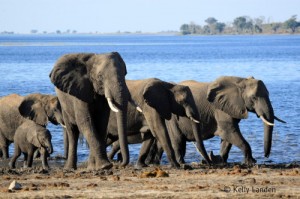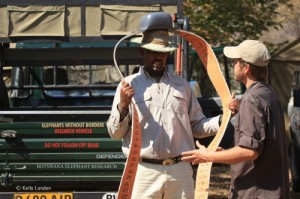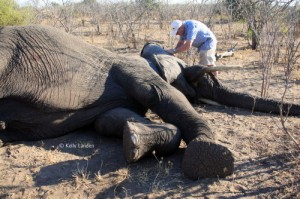New Satellite Collared Elephant, “Bemwo”
EWB spent the last week in the field of Chobe National Park with the intentions of deploying 2 new satellite tracking collars on bull elephants. (to read more about EWB tracking: http://www.elephantswithoutborders.org/tracking.php) We were successful at deploying only one. We had decided it best to dart from the ground rather than using a helicopter, considering the high density of wildlife, elephants and tourists in the area. Also, now that the cold, dry winter is in full swing, the vegetation is already becoming sparse, allowing us easy access through the brush.

larger Bulls are rare along the Chobe
We had decided to focus on large bulls, as they are becoming a rarity seen in the Chobe waterfront area. Young bulls and breeding herds are plentiful, but we would like to learn more about the random, larger bulls that occasionally come here.
We spent several days driving the park, searching from the sandy roads to locate a possible subject. It is fairly cold with temperatures ranging between 4ºC (39ºF) in the morns to 24ºC (75ºF) mid-day, and winds blowing upwards of 25km/hour throughout the day. Neither condition is conducive to elephants liking or need to utilize the river frequently. On some days, elephant numbers were limited and the large bulls were nowhere to be seen.
However, we were happy to see large numbers of many other species. The impala are at the end of their rutting season. Their displays, grunts and courting behaviors are quite entertaining. Buffalo have returned and the herds are spread throughout the waterfront drives. With buffalo, follow the lions and one particular pride lay satisfied over their evening’s meal.

Sable herds are more and more common
The zebra are completing their yearly round seasonal journeys and are beginning to appear at the Ngoma side of the park, waiting for the floodwater to subside to reveal kilometers of grazing pastures. Kudu are plentiful, as well as, surprisingly large herds of sable are now a regular sight. To everyone’s surprise giraffe seem to have had a sudden population “explosion” and “journeys” of giraffe with many young, were everywhere feeding on woolly-caper bushes. (to view more EWB photos, see: http://www.elephantswithoutborders.org/photo_gallery.php)
One afternoon, I stumbled across an elephant breeding herd 60 strong, accompanied by a bachelor herd of 12 and two beautiful, substantially large bulls. As luck has it, this sighting was on a spotting drive by myself and was not prepared to collar without the team assembled. The next day, we circled the same area relentlessly but they did not reappear.

Mike explains the collar, while Sammy demonstrates
However, one morning we came across a healthy, lone, size-able bull. It was decided that he would be one of our newest elephant ambassadors. The collaring exercise went very smoothly. The immobilization drugs took effect quite quickly. We moved in, attached the collar, took his measurements and attained blood samples. When the antidote was given, he stood up and immediately wandered off through the shrub, donning his new tracking collar. His name is Bemwo, named by our sponsors from the Swiss BMW Dealership Association, approximately 30 yrs of age, stands just over 3meters high at the shoulder and he bares modest, yet symmetrical tusks.
We are particularly excited about Bemwa’s collar. It is a new type of satellite collar created by Africa Wildlife Tracking in Pretoria, South Africa.

Larry administering the anti-dote to Bemwa
The battery life is supposed to last much longer than the previous models we’ve used, allowing us to download data location points every half hour throughout a five year span before having to retrieve the unit. (EWB colleagues: http://www.elephantswithoutborders.org/colleagues.php)
EWB would like to Thank all the BMW representatives that journeyed to Botswana. It was a pleasure meeting you and hope you enjoyed your trip here. We sincerely appreciate your support and are eager to share Bemwo’s journeys with you!
If you would like to support our projects, please log on to http://www.elephantswithoutborders.org/donate.php… We, the elephants, wildlife, and local communities Thank you!

Zebra have returned to the Chobe riverfront
Tags: africa, botswana, chobe, conservation, elephants, research, wildlife







